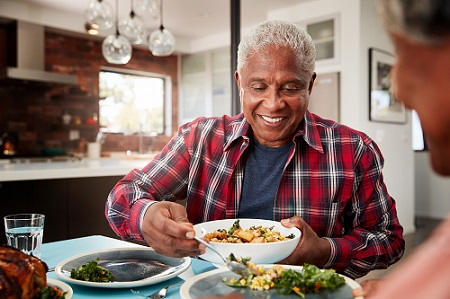Vegan? Low Sodium? High Fiber?
Many diet options, many things to consider
 It's easy to see how you might gain weight during the pandemic, especially if you're spending more time at home. During the COVID-19 pandemic, staying on track with your health goals might not be at the forefront of your mind. Even though you might not be ready to head to the gym or stop by your favorite smoothie shop at the moment, you can still make healthy food choices.
It's easy to see how you might gain weight during the pandemic, especially if you're spending more time at home. During the COVID-19 pandemic, staying on track with your health goals might not be at the forefront of your mind. Even though you might not be ready to head to the gym or stop by your favorite smoothie shop at the moment, you can still make healthy food choices.
One great way to improve your health is by making changes in your diet. Many diets are trending right now. Maybe a no meat, no dairy, or even a seafood-based diet has caught your attention. Whatever diet you choose to follow, remember that eating a wide variety of foods, including fruits and vegetables, is the best way to get the healthy nutrients you need.
The next time you want to switch up your diet, and improve your health, consider one of the options below:
Vegetarian and vegan
A Vegetarian or vegan diet focuses on eating plant-based foods. Instead of meat, you will choose fruits, vegetables, dried beans, peas, grains, seeds, and nuts. A vegetarian may also want to eat foods that include dairy and eggs. A vegan diet does not contain dairy, eggs, or animal-based foods.
Both diets are healthy and can give you the calories and nutrients that you need. Talk with a Registered Dietitian Nutritionist to ensure the foods you are choosing are meeting your nutrition needs. Your nutrition needs can depend on different factors, including health status and physical activity. Because you choose not to eat animal products with this diet, you need to make sure you're getting all the necessary nutrients and vitamins for optimal health.
With these recipes, you won't even miss the meat:
Pescatarian
If you're ready to give up meat but not ready to give up seafood, you could try a pescatarian diet. A pescatarian diet starts with a vegetarian diet but includes seafood. Fish is a good source of protein and is low in saturated fat, but it does not replace the B and D vitamins that come from meat. Talk with a Registered Dietitian Nutritionist to make sure you are getting key nutrients if you choose to follow a Pescatarian diet.
Try a quick and easy pescatarian recipe from VA's One-Pot Meals Cookbook (PDF).
Low sodium
If you have high blood pressure or heart failure, a great diet option for you is a low sodium diet. The higher your blood pressure, the greater your risk for heart disease, stroke, blindness, and kidney problems. Reducing salt can help you better control your blood pressure.
Some recipes that taste great while also skipping the salt include:
High fiber
To help reduce your risk for certain health problems, you could try a high fiber diet. Foods rich in fiber are often low in calories, plus they fill you up. If you're considering a high fiber diet, see which type of fiber is best for you:
Insoluble fibers don't dissolve in water and are found in whole grains, cereals, certain fruits and vegetables such as apple skin, corn, and carrots. They may prevent constipation and reduce the risk of certain types of cancer.
Soluble fibers dissolve in water and are found in oats, beans, and certain fruits and vegetables like strawberries and peas. It helps reduce cholesterol and control blood sugar levels.
If you're looking for a tasty high fiber snack, try making high fiber bran muffins. They're packed with one gram of fiber per tablespoon and taste amazing.
Before changing your diet, send your health care team or Registered Dietitian Nutritionist a Secure Message (sign in required) and discuss what's best for you. Tracking your diet in your My HealtheVet Food Journal is also a good way to keep an eye on your changes.
Please vote in our unscientific poll. All responses are anonymous.
Read More
Eat a Balanced Diet for Mental Health (Veterans Health Library)
How to Contact a VA Dietitian (Nutrition and Food Services)
Updated August 11, 2020

